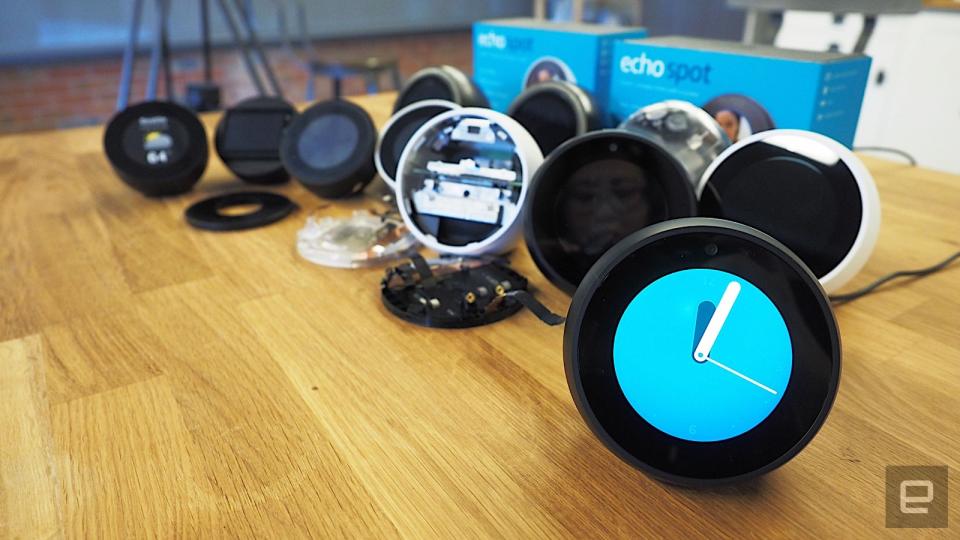Inside Amazon's quest to make a different kind of Echo
Giving the Spot personality required a fresh approach.
Of all the devices Amazon announced last fall, the one that got the most attention was the Echo Spot. A smaller, spherical version of the Echo Show, the Spot exuded an adorable style that was distinct from the rest of the Echo lineup. And judging by the reviews it received, it's clear that the Spot's form factor helped make it something of a surprise hit. In an exclusive behind-the-scenes look, Engadget had a chance to find out just how the Spot became one of Amazon's most unique products.
It all started in the days following the release of the original Echo. Amazon was taking a gamble with a new hardware category: an always-on personal assistant for the home. And as early customer feedback started to roll in, Amazon realized that Echo had to grow beyond voice commands.
"We realized that there were some use cases where it would probably be more friendly if you could confirm things on a display," said Miriam Daniel, Amazon's director of product management.
This sparked the idea for the Echo Show, the first Echo product with a screen. Just like the original, the Show was designed to be in a high-traffic area of the home, like a kitchen or hallway. As such, it had a 7-inch screen so you could see it from across a 7-to-10-foot room. While Amazon didn't know it at the time, the Show would prove to be the prototypical smart display, setting off a trend that rivals like Google would latch onto with their own Assistant-powered hardware.

But halfway through the Show's production, Amazon realized some people might prefer to put it on their desks or nightstands, in which case the 7-inch display might be too big. "We knew what the Show was going to look like," as the design was already finalized. "But maybe, what we needed was a smaller, mini-Show." Almost, she added, like a smart alarm clock.
Until then, options for something like that were either glorified phone stands, Echo Dot speaker docks or third-party Alexa-integrated options (that were little more than fancy clock radios). That's not to say that some weren't clever -- the Vobot has a cool LED Matrix display, for example -- but they just weren't as fully featured as Amazon's ambitions for the Spot.
Amazon likes to say that adding a display to the Echo was due to customer feedback, but the decision seems pretty obvious. There are already products that transform tablets into kitchen displays, and the Show is a natural progression of that. Even smart alarm clocks aren't new -- remember the Chumby? What Amazon wanted to do with the Spot, however, was take a smart display and combine it with the already successful Alexa platform.

When Amazon tasked design team Lab 126 to dream up a miniature Show, the first concept it came up with was basic: a printout of a round display taped onto an Echo Dot. Amazon was immediately enamored with the idea of a circular design, though, and started building spherical prototypes. But entering new product categories always comes with a risk. Something Amazon knows only too well after the Fire phone flop.
"We knew we wanted [the Spot] to be really small, really cute, so that it'll replace the alarm clock on your bedside table," said Daniel. "But as we started thinking and talking more about it, we thought, well, people will still want more information on the display." Another concern was that Spot wouldn't be big enough to house a good quality speaker. Smart speakers like the Echo Dot and the Google Home Mini aren't famed for their sound, but they don't have displays, are much cheaper and the consumer expectations are potentially much lower.
The team did consider other form-factors, looking at household objects like tea tins, storage containers and even phone docks. Should Spot be more of a cube? Or a 5-inch tablet that could rest on a stand? The cube would get better back volume and thus, better audio quality, while a tablet would have a more functional display. Amazon built prototypes of these, too, just in case.
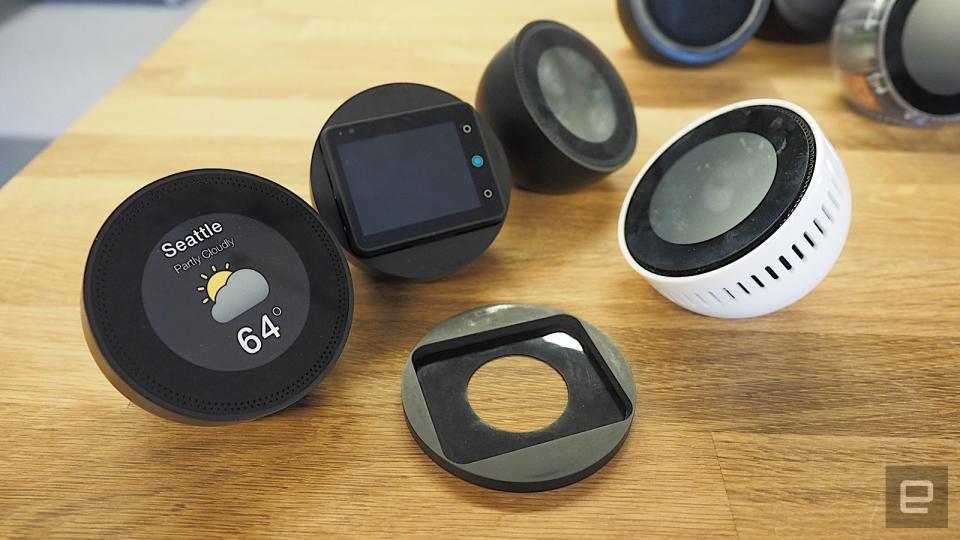
The Echo Show and Google-powered hardware (from the likes of Lenovo, JBL and LG) all follow the rectangular theme. They each have different characteristics of course -- JBL and LG styled their products like stereos, while Lenovo's Smart Display resembles a tablet in a photo frame.
But in focus group after focus group, Amazon customers wanted the spherical design. "They used words like 'cute,' 'friendly,' 'warm,' 'engaging,'" said Daniel. "It validated our initial instincts." However, this meant that Amazon still needed to overcome the practical limitations of a spherical form. Additionally, it's not as if a spherical design would be a hit even with such positive feedback -- Google's Nexus Q had a ball-like shape too, and that was a commercial fiasco. The Spot needed to not just be spherical, but for that shape to make sense.
Daniel explained that previous Echos were made to blend into the background -- though we're not sure a giant cylindrical speaker in your home is what you'd call inconspicuous. The Spot, on the other hand, was made to live on a home-office desk or on your bedside table. In other words, it had to stand out. "It has to earn its spot on your desk."
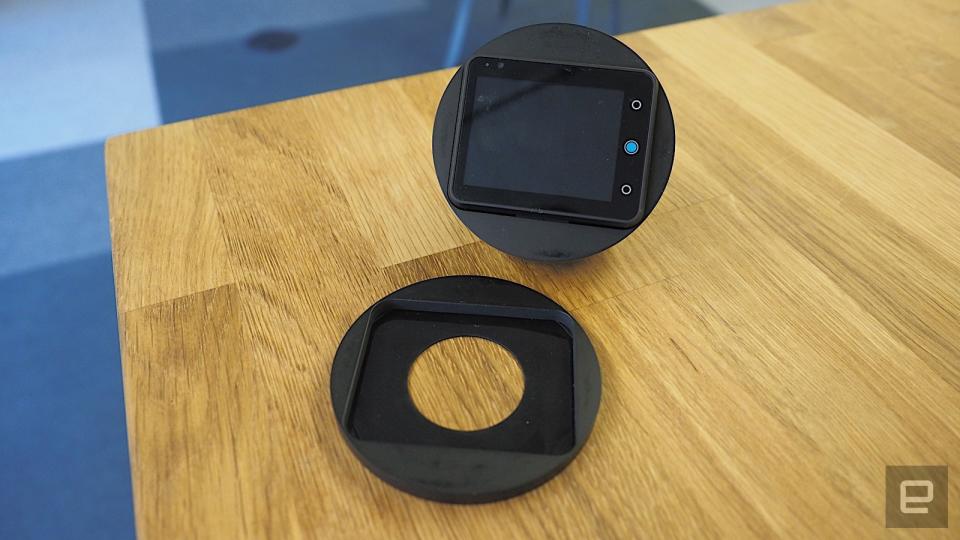
Now that Amazon was set on a spherical design, the trick was to wedge in all the desired functionality into its awkward ball-like shape. The team started with the guts of an Echo Dot, building a spherical shell around it. From there, they started thinking about the Spot's screen. "There were no real displays available off the shelf that would fit in this form factor," Daniel said.
The design team initially thought they could take a square screen and mask it with a magnetic plate, so you'd just see a circular section of it. But the result was not only impossibly small -- barely an inch wide -- the bezel was also superthick. What's more, powering a display, far-field microphones and full streaming audio inside such a small device created problems with heat.
While the original Spot prototype was the size of a plum, the final product is more like a grapefruit. The bezel was eventually reduced though, in part, thanks to a custom octagonal display. Amazon realized this would inflate the Spot's price tag, but gambled on that the circular aesthetic winning buyers over from rivals like Google.
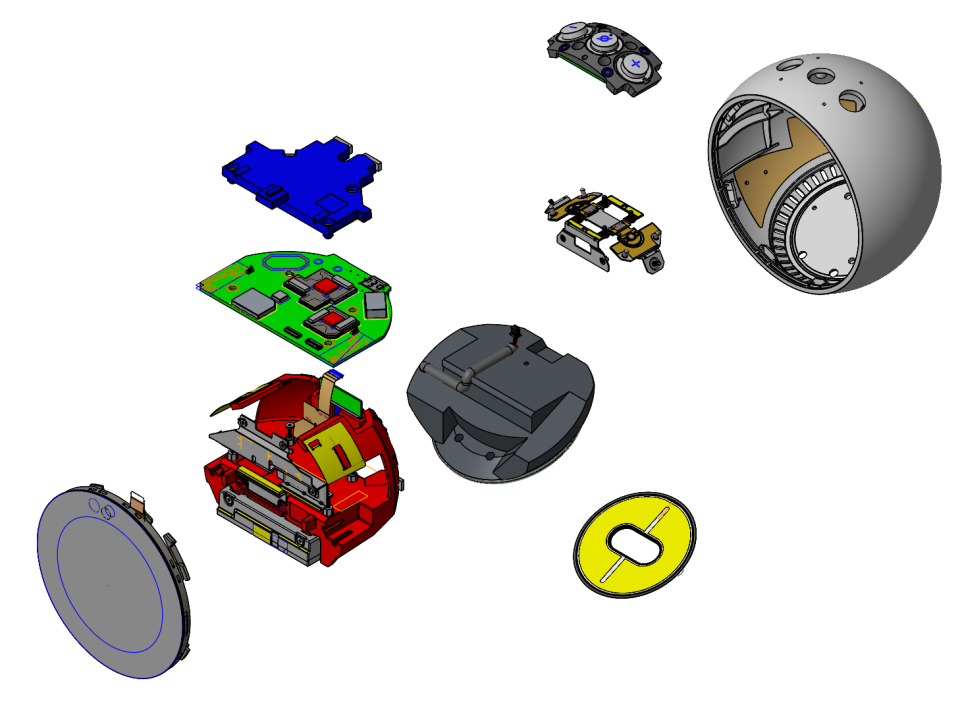
One of the biggest challenges Amazon faced when making the Spot was fitting the microphones inside. Instead of the seven far-field mics found in the rest of the Echo lineup, the Spot had to make do with four. "It was a really hard-fought battle with our audio and industrial design team," said Daniel. "We said, you gotta do more with less. You have to make the four microphones to perform just as well as the one with seven." In the end, Daniel said, they made it work through software. Based on my own experience with the Spot, it delivered; it could listen to my commands even when I was across the room.
Another cause for debate was whether or not the Spot should have a camera. When asked about potential privacy issues (a camera in the bedroom!), Daniel brushed it aside. Amazon hardwired the Spot's mute button to turn off both the microphone and the camera, believing this solved the issue. "Because we had that fallback, that wasn't our debate," Daniel said. But even if Daniel and her team believe that it still doesn't squelch the concern of privacy in the mind of many consumers.
"Our debate was 'What would customers use it for?' We can see people wanting to quickly do video intercom within the home," she continued. "We see that as one of our flagship use cases for this. You're in the kitchen, someone's in the bedroom, and you want to quickly drop in and say 'Hey, dinner's ready.'" In my review, I also noted the display is too small for long videos like movies, but Daniel is confident it works for trailers or news clips. "What we learned was, it wasn't a binary 'yes' to video or 'no' to video; the use cases would adapt to where and how you would use it."
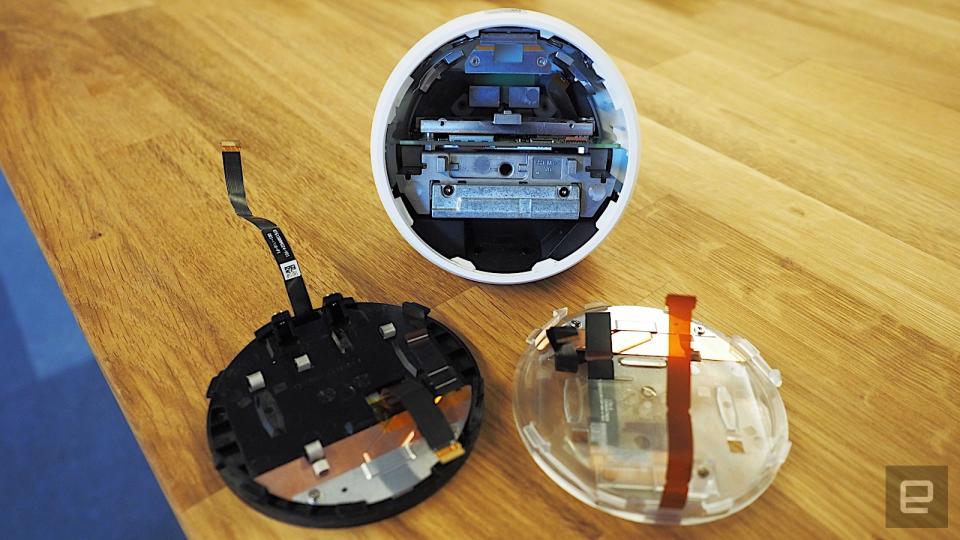
There were cosmetic issues, too. Amazon knew that a custom display, a camera and bigger audio drivers would add cost to the Spot, but it also wanted to make sure the Spot had a high-end finish. The final result is, without doubt, a great-looking product. It's cute, it's polished and gives off a modern alarm clock vibe.
Because the Spot was designed to be used three to five feet away -- instead of across the room -- the UI needed a rework too. Interacting with the Spot was a little more touch-forward than voice-forward. "There are some use cases where you might want to touch it, like if you wake up before the alarm goes off, you'll want to turn off the alarm without having to scream at it," said Daniel. In practice, this is certainly possible -- you can just tap the screen to shut it off -- though the reality is you may find that feeling around for the display when you're half-asleep isn't that intuitive either, so the system's not perfect.
The Spot also introduced a feature called Routines -- a set of actions triggered with a simple command. For example, if you say "Good morning," you can have that prompt the Spot to give you the weather, traffic info, a joke of the day, play a video clip of the news headlines and turn on your coffee maker. Or you can say "Good night" to turn off the lights and play a sleepy soundtrack. Siri and Cortana let you group smart-home devices by command as well, but it can't bundle in extras like weather and news briefings. As for Google Assistant, that didn't even get Routines support until a few weeks ago.
Still, the UI tweaks that Amazon made might only be a step in the right direction. After trying out a few rivals at CES, it feels like the upcoming Google-powered devices are better in almost every way. Searching for recipes brings up a step-by-step guide, and asking for directions will not only display the map, but it'll also automatically send them to your phone without you having to ask. Amazon is likely aware of the new competition and the challenges it faces to keep up.
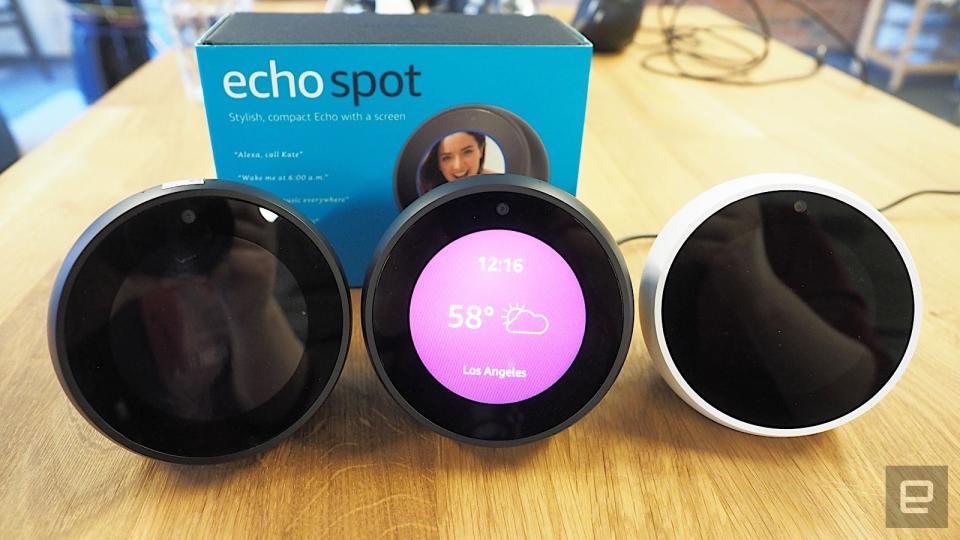
Developing Echo Spot took between 12 to 14 months, but the gamble seems to be paying off. Amazon wouldn't give us exact sales figures but did say that the Spot has an average 4.4-star customer rating. If you live by Amazon star-ratings, that's pretty good.
Yet, as nice as the Spot is, it's not perfect. Despite all that R&D, Amazon never really did completely solve the Spot's audio-quality issues. After a few weeks, I stopped using it for music entirely because I just couldn't stand the mediocre sound. I never really got used to the small, tiny news videos, and almost never use the display for anything more than the time and weather. It's also worth mentioning that due to various custom components, the Spot retails for a pretty high price -- $130 is a lot to pay for what amounts to a fancy alarm clock.
As we mentioned earlier, though, Amazon blazed the trail for smart displays, and it's now facing tough competition from Google-powered hardware, like Lenovo's Smart Display, the JBL Link View and the LG ThinQ View WK9. The Spot is Amazon's latest success story, but it's a rapidly evolving market.
Amazon isn't concerned. "We don't worry about competitor products," said Daniel of Amazon's rivals. "We're looking forward versus looking sideways."
